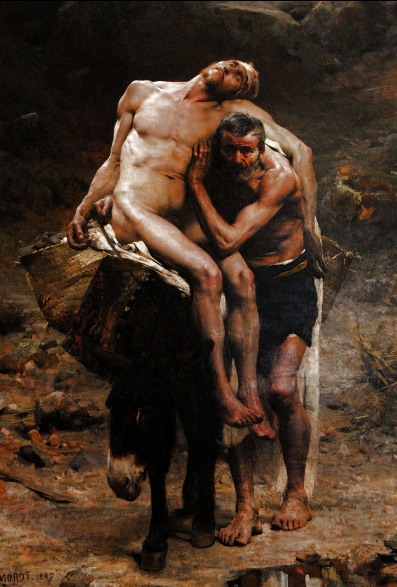Sunday Lectionary: The Hippo Gospel
 I thought I’d write a brief entry on today’s Gospel, the parable of The Good Samaritan. The interpretation I’m going to give may be one you’ve never heard before. It comes from St. Augustine, bishop of fifth century North Africa in his work “Questions on the Gospels”.
I thought I’d write a brief entry on today’s Gospel, the parable of The Good Samaritan. The interpretation I’m going to give may be one you’ve never heard before. It comes from St. Augustine, bishop of fifth century North Africa in his work “Questions on the Gospels”.
I had never heard of this interpretation of the parable until I started studying the Early Church Fathers where I found this explanation also offered by others such as Ireneus and Origen.
I’ll talk about the Early Church Fathers specifically in another post, but for now, let’s look at one of the ways St. Augustine explained this parable:
On one occasion an expert in the law stood up to test Jesus. “Teacher,” he asked, “what must I do to inherit eternal life?”
“What is written in the Law?” he replied. “How do you read it?”
He answered: ” ‘Love the Lord your God with all your heart and with all your soul and with all your strength and with all your mind’; and, ‘Love your neighbor as yourself.’“
“You have answered correctly,” Jesus replied. “Do this and you will live.”
But he wanted to justify himself, so he asked Jesus, “And who is my neighbor?”
In reply Jesus said: “A man was going down from Jerusalem to Jericho, when he fell into the hands of robbers. They stripped him of his clothes, beat him and went away, leaving him half dead. A priest happened to be going down the same road, and when he saw the man, he passed by on the other side. So too, a Levite, when he came to the place and saw him, passed by on the other side. But a Samaritan, as he traveled, came where the man was; and when he saw him, he took pity on him. He went to him and bandaged his wounds, pouring on oil and wine. Then he put the man on his own donkey, took him to an inn and took care of him. The next day he took out two silver coinsand gave them to the innkeeper. ‘Look after him,’ he said, ‘and when I return, I will reimburse you for any extra expense you may have.’
“Which of these three do you think was a neighbor to the man who fell into the hands of robbers?”
The expert in the law replied, “The one who had mercy on him.”
Jesus told him, “Go and do likewise.”
Making Senses Of Scripture
A scripture passage can have many “senses”. For example, a passage can have:
1. A literal sense: What actually happened
2. A moral sense: What lessons it teaches us about just living
3. An allegorical sense: What it teaches us, through symbols, about Christ
A particular passage may have more than one sense at the same time – God is clever like that. So, in this parable, as well as providing the lawyer with an answer to his moral question “Who is my neighbor?”, St. Augustine teaches us that this parable is an allegory concerning Christ.
The Samaritan Christ
The man on the journey represents Adam, who is on a journey away from Jerusalem, the heavenly city of peace where God dwells. The man is headed away from God’s presence towards Jericho, the worldly city of sin, mortality and death. The man is attacked by robbers who represent Satan and his angels. In this fall, Adam is robbed of all he has – his immortality, his intimate relationship with God and his other “preternatural gifts”. Adam’s sin leaves him and his children deeply, deeply wounded.
The Priest and Levite appear on the scene, representing the Old Covenant, but by choosing to not help the man in favour of obeying the purity laws (Lev 21:1), these characters demonstrate the inability of the Old Covenant to restore life to the half-dead Adam.
However, then enters the figure of the Samaritan, Jesus. He demonstrates the mercy brought about by the New Covenant. He binds up the man’s wounds, pouring on oil and wine. These actions demonstrate a saviour who binds up our wounds (Psalm 147:3), anoints and heals us with oil (James 5:14) and fills us with the “new wine” of the Spirit (Acts 2:13). Or as Augustine puts it: “The binding of the wounds is the restraint of sin. Oil is the comfort of good hope; wine the exhortation to work with fervent spirit”
The Samaritan then carries the man to the inn which, for Augustine, is the Church. It is here where the man is nurtured back to health with the sacraments and refreshed for his journey back to his heavenly home. The Samaritan, like Jesus (Luke 24:51), then leaves, but not before leaving behind a deposit with the keeper of the inn (Apostle) for the provision of the man’s care in his absence. The Samaritan then promises to return (Revelation 22:20) and to pay the entirety of the man’s debt (Romans 4:25).

Conclusion
Some people dismiss all “spiritual” readings of Scripture such as the one I have given above, choosing to restrict themselves to only the literal meaning of the text. To be fair, we should be careful not to “over-spiritualize” the sacred texts or overlook the literal sense, but it is a mistake to dismiss the allegorical sense completely since both Jesus and Paul used allegory when explaining Scripture. I will talk more about this and the different senses of Scripture in another post.
There is, in fact, a profound harmony between the more obvious sense of this parable and the explanation provided above. In the former, we are shown how it is we should love all those around us, and in the latter it is demonstrated that it is Christ Himself who loves this way. Ultimately therefore, this parable is a call to imitate Christ, loving the world as He loves. All those, therefore, who are called His disciples, “Go and do likewise”.
Beautiful. Thanks for sharing.
Thank you for writing this. Loved reading it!